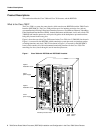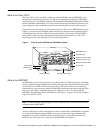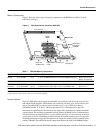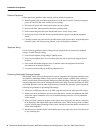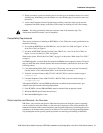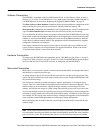
10 7000 Series Route Switch Processor (RSP7000) Installation and Configuration in the Cisco 7000 Series Routers
Installation Prerequisites
Caution All CxBus interface processors support OIR; however, you must shut down the system
before removing or installing the RSP7000, which is a required system component. Removing an
RSP7000 while the system is operating will cause the system to shut down or crash, and might
damage or destroy memory files.
Each RSP7000 and interface processor contains a bus connector with which it connects to the system
backplane. The bus connector is a set of tiered pins, in three lengths. The pins send specific signals
to the system as they make contact with the backplane.
The system assesses the signals it receives and the order in which it receives them to determine what
event is occurring and what task it needs to perform, such as reinitializing new interfaces or shutting
down removed ones. For example, when you insert an interface processor, the longest pins make
contact with the backplane first, and the shortest pins make contact last. The system recognizes the
signals and the sequence in which it receives them. The system expects to receive signals from the
individual pins in this logical sequence, and the ejector levers help to ensure that the pins mate in
this sequence.
When you remove or insert an interface processor, the backplane pins send signals to notify the
system, which then performs as follows:
1 Rapidly scans the backplane for configuration changes and does not reset any interfaces.
2 Initializes all newly inserted interface processors, noting any removed interfaces and placing
them in the administratively shutdown state.
3 Brings all previously configured interfaces on the interface processor back to the state they were
in when they were removed. Any newly inserted interfaces are put in the administratively
shutdown state, as if they were present (but unconfigured) at boot time. If a similar interface
processor type has been reinserted into a slot, then its ports are configured and brought online up
to the port count of the original interface processor.
OIR functionality enables you to add, remove, or replace interface processors with the system
online, which provides a method that is seamless to end users on the network, maintains all routing
information, and ensures session preservation.
When you insert a new interface processor, the system runs a diagnostic test on the new interfaces
and compares them to the existing configuration. If this initial diagnostic test fails, the system
remains off line for another 15 seconds while it performs a second set of diagnostic tests to
determine whether or not the interface processor is faulty and if normal system operation is possible.
If the second diagnostic test passes, which indicates that the system is operating normally and the
new interface processor is faulty, the system resumes normal operation but leaves the new interfaces
disabled. If the second diagnostic test fails, the system crashes, which usually indicates that the new
interface processor has created a problem on the bus and should be removed.
The system brings online only interfaces that match the current configuration and were previously
configured as up; all other interfaces require that you configure them with the configure command.
On interface processors with multiple interfaces, only the interfaces that have already been
configured are brought online.
For example, if you replace a dual-interface Ethernet Interface Processor (EIP) with an EIP with four
interfaces, only the previously configured interfaces are brought online automatically; the new
interfaces remain in the administratively shutdown state until you configure them and bring them
online.



